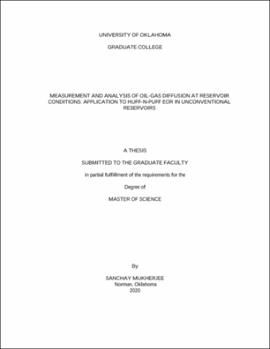| dc.description.abstract | Due to the extremely low permeability and high depletion rate, primary recovery from unconventional reservoirs is generally low. Huff-n-Puff has proved to be a successful EOR technique in tight formations, such as the Eagle Ford. However, the underlying transport mechanism remains poorly understood. Recent studies show oil-gas diffusion is a key factor in huff-n-puff EOR. Due to concentration gradients, injected gas molecules diffuse into in-situ oil causing it to swell and consequently to be expelled out of the nanopores into the micro- and macro- fractures.
We have designed an experiment with a high-pressure, high-temperature cell having observation windows for the measurement of oil swelling and diffusivity. The measurements have been done on Wolfcamp A oil (API-32), Meramec oil (API-43) and Eagle Ford oil (API-53) with 3 different gas mixtures of methane – ethane, at a temperature of 175°F to evaluate the impact of injection pressure (above and below Minimum Miscibility Pressure-MMP), injectate gas composition, API gravity and viscosity of oil on oil-gas diffusivity.
The results show that the diffusivity of injectate gas into the oil phase as a function of pressure and increases to maximum at MMP, beyond which it decreases. Enrichment of the injection gas increases the oil-gas diffusivity at the same pressure. Regardless of injection pressure, for the gas mixture C1/C2 (72/28 mole%) the diffusion coefficient varies between 10-11 m2/s to 10-10 m2/s for Wolfcamp A oil; 10-10 m2/s to 10-9 m2/s for Meramec oil and 10-9 m2/s to 10-8 m2/s for Eagle Ford oil.
Tight reservoirs generally have a high matrix tortuosity, which impacts the diffusion efficiency in the porous media. Using tortuosity values available in the literature and diffusivities of oil gas systems measured in this study, we estimate that the injected gas can only travel 0.2-0.9 ft away from the fracture-faces during 6 months of gas injection. Low tortuosity and high diffusion rates favor economic recoveries. This study highlights the importance of stimulated reservoir area (SRA) characterization, nanoporous tortuosity and diffusivity measurements in optimizing huff-n-puff recovery in shales. | en_US |
